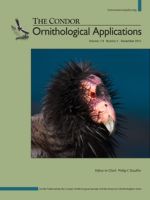The Cooper Ornithological Society is pleased to recognize Dr. Daniel Baldassarre and Dr. Peter Hosner as the 2016 recipients of the Young Professional Award (YPA). First awarded in 2009, the YPA recognizes early career researchers for their outstanding scientific research and contributions to the ornithological profession.
Daniel Baldassarre studies the intersection between behavioral ecology and speciation. In 2014, he received his Ph.D. from Cornell University, where he studied how sexual selection influences speciation dynamics in the Red-backed Fairywren. This research entailed demographic studies of mating behavior in several wild populations, experimental manipulations, and genomic analyses. The project revealed strong sexual selection on divergent plumage color and song between 2 subspecies that results in complex genomic patterns of divergence and introgression. Subsequently, Dan was awarded an NSF Postdoctoral Research Fellowship at the University of Miami to study the evolution of blood feeding in the Vampire Finch of the Galápagos. For this research, he is quantifying ecological, behavioral, and genomic variation among blood-feeding and non–blood-feeding populations. He recently accepted a position as a Postdoctoral Associate in the Riehl Lab at the Princeton University Department of Ecology and Evolutionary Biology and is planning a project investigating phenotypic plasticity in desert and woodland breeding populations of the Phainopepla in southern California. Dan's research is often motivated by bizarre natural history, which inevitably leads him to exciting and fruitful research projects.
YPA Award Talk abstract: Connecting pattern and process in the study of avian speciation. A longstanding question in evolutionary biology is whether divergence in sexual signals leads to speciation. Traditionally, researchers have tackled this question using a broad phylogenetic framework. A more powerful approach is to examine closely related taxa at an intermediate point along the speciation continuum, combining phylogeographic and behavioral analyses to elucidate both pattern and process. The Red-backed Fairywren (Malurus melanocephalus) is an Australian endemic classified as 2 subspecies based on variation in male plumage color and song. I will present the pattern of genomic and morphological variation between subspecies, and share results of field experiments examining how sexual selection affects those patterns. I used spatial modeling and genomic techniques to analyze divergence and gene flow between subspecies. I then conducted plumage manipulation and mount presentation experiments to examine how male and female response to these multimodal signals may explain the broader patterns. The results suggest that the 2 sexes respond differently to the suite of divergent signals, and that extra-pair paternity plays a strong role in the evolution of reproductive isolation. I will suggest that divergence in sexual signals does not always lead to speciation, and can in fact increase gene flow and produce complicated phylogeographic patterns that may be more common across taxa.
Peter Hosner investigates how geographical, environmental, and ecological factors limit avian distributions and how these factors influence patterns of diversification. To understand the geography of avian diversification, Peter infers evolutionary relationships and population history of bird species/populations with genomic data to test predictions from geological models, ecological niche modeling, and phenotypic assessments in comparative frameworks. His projects encompass multiple scales, from higher-level projects on major bird radiations to fine-scale studies of closely related species/populations. For his Ph.D. at the University of Kansas, Peter examined the relative roles of geologic, marine, and environmental factors in isolating diversifying bird populations in the Philippine archipelago. He is currently a Postdoctoral Associate at the University of Florida, where he is using DNA sequences of genome-wide ultraconserved elements to resolve landfowl phylogeny. Peter's research projects are specimen-based, utilizing new material collected during field expeditions supplemented with historical material collected by previous generations of museum biologists. He has led and conducted fieldwork in 12 countries in the Americas and Asia. These field expeditions have resulted in 2 newly described bird species to date, one from Peru and one from the Philippines.
YPA Award Talk abstract: Avian diversification in the Philippine archipelago. Island archipelagos are natural laboratories contributing disproportionately to human understanding of evolution. In large-bodied and mobile animals such as birds, population subdivision across complex continental landscapes is regular. By contrast, in oceanic archipelagoes new populations are thought to be formed solely by dispersal to unoccupied islands. Here, I show that within-landmass divergence is ubiquitous in avian lineages endemic to the Philippine archipelago. Population-level phylogenies of 20 such co-distributed groups illustrate that initial geographic isolation and subsequent formation of coexisting lineages evolve within single islands. Processes driving speciation in continental and insular speciation are not unique or separate. On islands, like continents, climate change and the geographical template function to isolate populations, whereas ecological specialization across environmental gradients regulates their coexistence. Much Philippine avian species diversity is unrecognized at the species level, obfuscating these patterns and concealing dire conservation needs.
Two YPA awardees are selected annually to present on their work at the Young Professional Award Plenary session held at the Annual Meeting. The 2 awardees also receive a cash prize, travel support to the meeting, and are honorary guests at a reception attended by the COS President and other officers and the YPA committee. For eligibility criteria and how to apply, go to http://www.americanornithology.org/content/younginvestigator-awards#cos-young-investigator-award.







